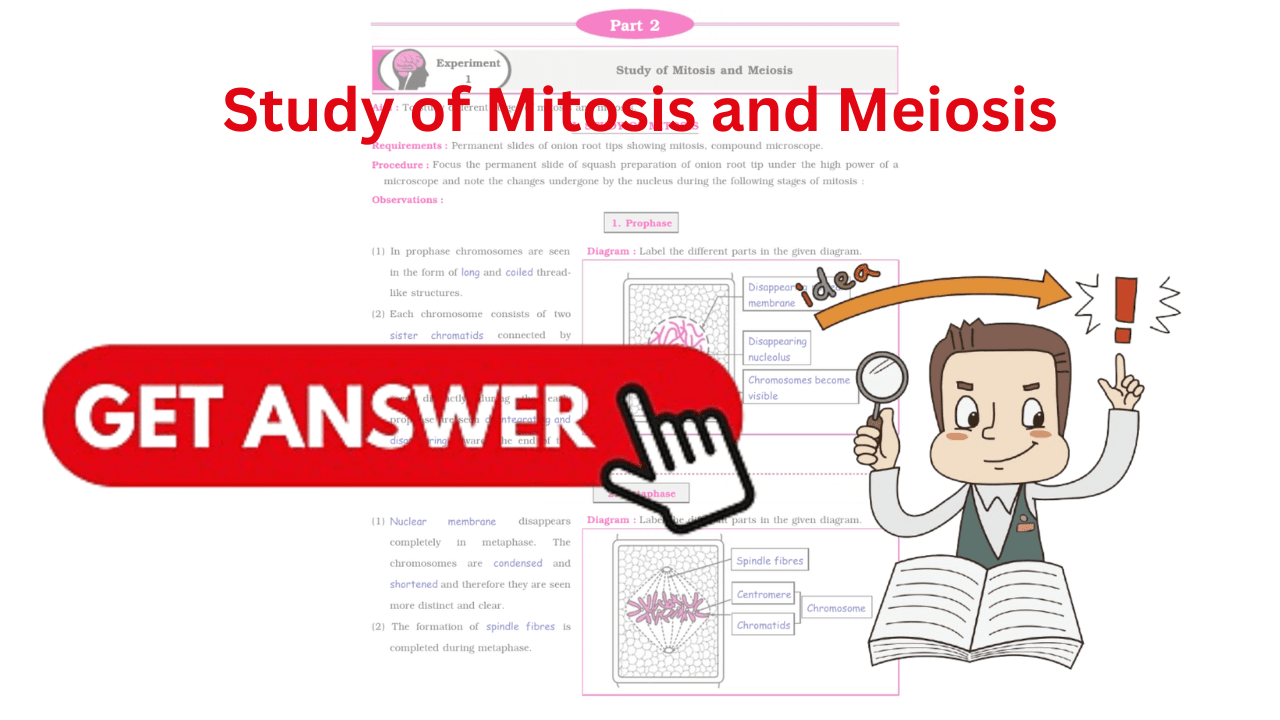Standard 10th Science Biology Experiment 1 Answer Solutions: Study of Mitosis and Meiosis Practical Answer Solutions
Aim :
To study different stages of mitosis and meiosis.
I. STUDY OF MITOSIS
Requirements :
Permanent slides of onion root tips showing mitosis, compound microscope.
Procedure :
Focus the permanent slide of squash preparation of onion root tip under the high power of amicroscope and note the changes undergone by the nucleus during the following stages of mitosis :
Observations :
1. Prophase
(1) In prophase chromosomes are seenin the form of long and coiled thread-like structures.
(2) Each chromosome consists of two sister chromatids connected by centromere.
(3) The nuclear membrane and nucleolus seen distinctly during the early prophase are seen disintegrating and disappearing towards the end of the prophase.
2. Metaphase
(1) Nuclear membrane disappears completely in metaphase. The chromosomes are condensed and shortened and therefore they are seen more distinct and clear.
(2) The formation of spindle fibres is completed during metaphase.
(3) Where are spindle fibres formed ?
Spindle fibres are formed between centromere of each chromosome and both centrioles of opposite poles.
(4) How are chromosomes arranged during this phase?
The chromosomes are seen arranged at equatorial plane of the spindle, during this phase.
3. Anaphase
(1) Which important division process takesplace during anaphase?
In this phase, centromere split and sisterchromatids of each chromosome separateand move towards the opposite poles due tothe contraction of spindle fibres.
(2) The chromosomes appear ‘L’ or ‘V’ shapedduring anaphase.
4. Telophase
(1) What change takes place in thechromosomes during this phase?
The chromosomes are seen assembled atthe poles in the form of long coiled thread-like structures.
(2) What are important changes duringtelophase?
During telophase the chromosomesreorganise to form two daughter nuclei atopposite poles.
(3) The nuclear membrane and nucleolus reappear at the end of telophase forming two daughter nuclei. The process of cytokinesis takes place at the end forming two daughter cells.





II. STUDY OF MEIOSIS
Meiosis is also called reduction division because the chromosome number is reduced to half.
Requirements :
Slides of grasshopper testis showing meiosis, compound microscope.
Procedure :
Focus the permanent slides of meiosis under the high power of a compound microscope. Observethe slides carefully and note the details.
Observations :
(1) What are the main divisions of the meiosis? (
A)Meiosis I (B)Meiosis II
(2) Which is the most elaborate phase of the meiosis I ? What are its substages?
Prophase ‘I’ is the most elaborate phase of the meiosis I.
5 substages of prophase I are as follows : Leptotene, Zygotene, Pachytene, Diplotene, Diakinesis.
(3) At the end of Meiosis I, diads, i.e.
2 distinct cells are visible. The chromosome number is reduced to half.
(4) At the end of Meiosis II, tetrads, i.e. 4 distinct daughter cells are visible.
Meiosis I
Identify the diagrams of different phases of Prophase-I and name them. Label the different parts of eachphases and write atleast two characteristics of each phases
Multiple Choice Questions
Choose the correct alternative and write its letter (A), (B), (C), (D) in the box :
1. Which type of cells show mitotic cell division?
(A) Somatic (B) Germinal (C) Somatic and Germinal (D) None of the above
Answer: C
2. In which phase of mitosis, the chromosomes are at the equatorial plane?
(A) Prophase (B) Metaphase (C) Anaphase (D) Telophase
Answer: B
3. How many cells can be formed if cell divides 6 times by mitosis?
(A) 32 (B) 44 (C) 64 (D) 72
Answer: C
4. Which of the following material can be used to observe meiotically dividing cells?
(A) Onion root tip (B) Grasshopper testis (C) Potato starch grains (D) Cheek cells of human
Answer: B
5. Which one is the most important difference in mitosis and meiosis?
(A) Number of daughter cells formed (B) Number of chromosomes in daughter cells (C) Amount of cytoplasm in daughter cells (D) Time required for the cell division
Answer: B
